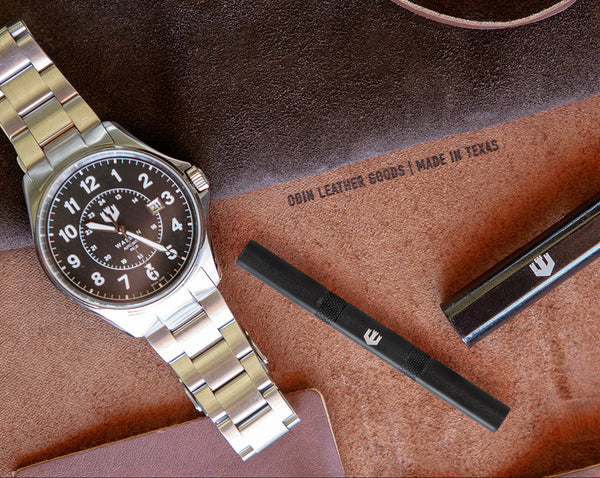
The Case for a $945 Watch
If you’re anything like me, you may have spent much (or all) of your life completely unaware of the world of automatic, mechanical watches. If you had asked me ten years ago what I considered an expensive watch, I would have said $300. If you had asked me what the odds of me buying a watch for $945 were, I probably would have laughed.
But all of that changed for me when I read an article about how members of US Army Special Forces and other special operations organizations often wear Rolexes and other high-end, automatic watches in the field. Having served in the US Marine Corps myself, I was curious as to why on earth anyone would wear a $10,000 timepiece on their wrist to battle. What I learned in that article and have learned since then has been eye-opening.
For starters, let’s talk about what an automatic mechanical (also known as self-winding) watch is to begin with. This type of watch uses a movement that is mechanical, and uses the motion of your wrist to wind itself. That means it doesn’t require batteries.
The way it works is that a rounded piece of metal called a rotor turns clockwise or counter-clockwise depending on the movement of your wrist. The rotor turns a transmission wheel, which turns the mainspring, which is where all the energy is stored.

It works similar to a watch that you would wind by hand, only an extra mechanism is in place to do the winding for you.
If you’re not familiar with this technology already, you may be surprised to find out that it has actually been around since the late 1700’s. Today most non-smart watches sold utilize quartz movements that are battery powered. This technology is relatively new. The first quartz wristwatch was released by Seiko in 1969. Initially quartz watches were comparatively expensive, but over time this “new” technology grew in affordability and popularity until it became the dominant watch on the market.
Yet, automatic, mechanical watches still exist, and their market share in the luxury watch segment grows each year. Why?
I’ll tell you.
Rugged Reliability - Automatic Mechanical movements are typically made almost entirely of metal, with small jewels for ball bearings in all the joints. Many automatic movements have upwards of 20 or 30 jewels. Quartz movements are typically manufactured much more cheaply, often utilizing one jewel or analog movements. Digital quartz watches have no moving parts, but have circuits and internal plastic components. All quartz watches utilize a battery, which can die, or corrode, leading to catastrophic damage to the watch itself. Compared with quartz watches, automatic watches tend to last a long time, easily outliving the wearer when serviced appropriately.
Recently I was in a car accident. Thankfully no one was severely injured, but my car was totaled. The airbags deployed on my side, and I happened to be wearing my Wasson Automatic Field Watch. I had a red mark going halfway up my forearm from where the airbag had hit my watch and shoved it up my arm. Where the airbag had come into contact with my shoulder directly I was bruised and bleeding. But my watch? Not a scratch. It was ticking along like nothing happened.
No Batteries - I already touched on the battery issue a bit, but this is worth unpacking a little more. It’s one thing if your watch battery dies on you when you’re at home and nothing important is going on. If you’re extra on top of things you might even have the right battery sitting around, and if the watchback is easy to remove you can replace it yourself. But the thing is batteries don’t usually send you a memo to let you know when they’re going to die, and it can happen any time. It’s never ideal when your watch dies, but it can have severe consequences when you’re in the field and need to be able to track time accurately. On top of all that, there’s just something royally annoying about having to change batteries in your watch every couple of years. With an automatic watch you avoid all that.
Gorgeous Design - Have you seen an automatic movement? It is a work of art. Yes, the watch dial and case are the components that get almost all of the attention, but many automatic watches come with clear case backs so you can easily see the movement. In fact, some watches come with skeletonized dials so you can see the movement from the top. While these usually suffer in the category of readability, they can be quite stunning in the aesthetic department.
Honestly, I wear watches for my own enjoyment, but it doesn’t hurt that others get to enjoy them too. I get a lot of compliments on my Wasson Automatic Field Watch, and people always light up when I take it off and show them the movement through the sapphire crystal case back.
Cool Factor - Automatic movements are just cool. They’re exquisite. They’re beautiful. They’re rugged. They run on the power of your own wrist! Many automatic wristwatches represent hundreds if not thousands of production man-hours. You know that a lot of detailed, skilled labor went into that watch. Because of all the time, effort, and money that went into the movement, the rest of the watch tends to be a cut above. You won’t find a lot of automatic movements encased in plastic watches. More common materials include polished stainless steel, gold, titanium, and platinum. Instead of mineral crystals covering the dial that will scratch and make your watch difficult to read within a few months of wear, many automatic watches feature sapphire crystals, which are extremely scratch resistant.
Long Term Value - Because of all the things I’ve already mentioned, automatic watches tend to hold their value quite well. It's not uncommon for high-end timepieces to go up in value over time.
One of the reasons special operators and other folks who work in austere environments prefer high-end timepieces is the value factor. If things go bad - - like, your life's on the line kind of bad - - it never hurts to have something really valuable at your fingertips that you can use to barter for your life. For most folks this scenario is unlikely if not unthinkable, but for a unique few, it’s better safe than sorry.
At $945, the Wasson Automatic Field Watch is packed with value. It’s Swiss made with a Swiss, Ronda R-150 automotive movement with 25 jewels. It has a 316L stainless steel case and bracelet, front and back sapphire crystals, and is water resistant to 100 meters. The dial was uniquely and intentionally designed to balance aesthetics and readability.
The question is not, “How can you afford this watch?” The question is, “How can you afford not to?”


